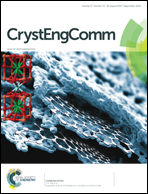Unravelling the mechanism of lithium insertion into and extraction from trirutile-type LiNiFeF6 cathode material for Li-ion batteries
Abstract
LiNiFeF6 was used as cathode material in lithium-ion cells and studied by in situ X-ray diffraction (XRD), in operando X-ray absorption spectroscopy (XAS) and 7Li MAS NMR spectroscopy. An optimised electrochemical in situ cell was employed for the structural and electrochemical characterisation of LiNiFeF6 upon galvanostatic cycling. The results for the first time reveal the lithium insertion process into a quaternary lithium transition metal fluoride with a trirutil-type host structure (space group P42/mnm). The in situ diffraction experiments indicate a preservation of the structure type after repeated lithium insertion and extraction. The lithium insertion reaction can be attributed to a phase separation mechanism between Li-poor Li1+x1NiFeF6 and Li-rich Li1+x2NiFeF6 (x1 ≲ 0.16 ≲ x2), where not only the weight fractions, but also the lattice parameters of the reacting phases change. The insertion of Li ions into [001]-channels of the trirutile structure causes an anisotropic lattice expansion along the tetragonal a-axes. An overall increase in the unit cell volume of ~6% and a reduction in the c/a ratio of ~4% are detected during discharge. Changes of atomic coordinates and distances suggest the accommodation of intercalated lithium in the empty six-fold coordinated 4c site. This is confirmed by 7Li MAS NMR spectroscopy showing two Li environments with similar intensities after discharging to 2.0 V. Furthermore, in operando XAS investigations revealed that only Fe3+ cations participate in the electrochemical process via an Fe3+/Fe2+ redox reaction, while Ni2+ cations remain electrochemically inactive.


 Please wait while we load your content...
Please wait while we load your content...